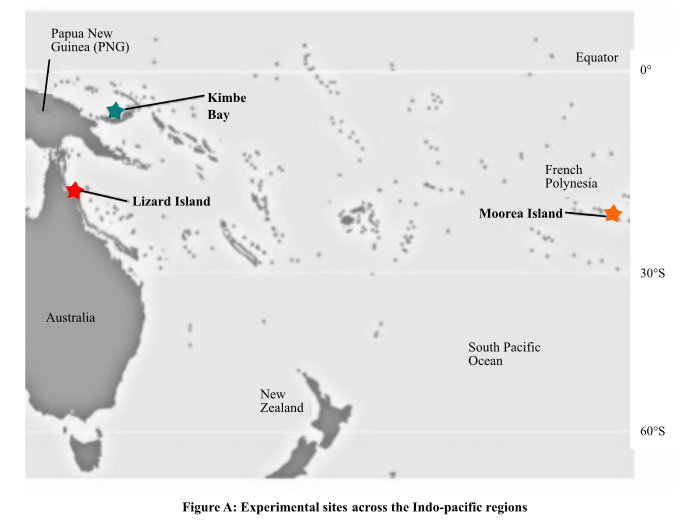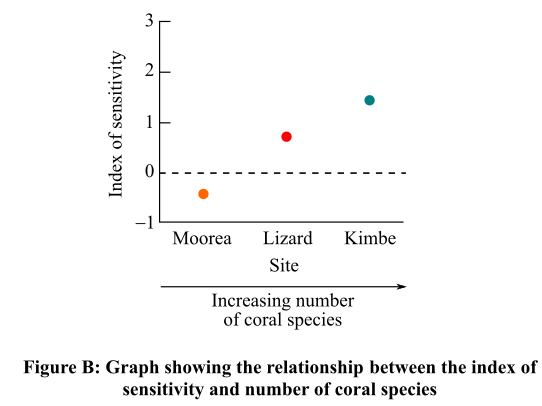
Concept explainers
To review:
The site on the map, where the species diversity of corals and the fishes would be more and least affected due to immigration or dispersal.
Given:
Figure 1 shows the study area of the experiment in the Indo-pacific region with high coral reef species. The three sites are Kimbe Bay in Papua New Guinea (PNG), Moorea Island in French Polynesia, and Lizard Island in the Great Barrier Reef on the east coast of Australia.

Figure 1: Experimental sites across the Indo-pacific region.
Graph 1 shows the results of the number of the fish species found in the coral species region. A relationship was established between the index of sensitivity and the number of coral species.

Graph 1: Relationship between the index of sensitivity and number of coral species.
Introduction:
An experiment was conducted in the three islands, Kimbe Bay (highest fish diversity), Moorea island (lowest number of fish species), and Lizard island (with an intermediate number of fish species). In the experiment, the coral diversity was manipulated and associated fish species were counted during a 12-month period. Based on this experiment, an index of sensitivity was calculated to evaluate the relationship between the number of coral species and the number of associated fish species that inhabited in the plots.
Want to see the full answer?
Check out a sample textbook solution
Chapter 53 Solutions
Life: The Science of Biology
- With respect to planktonic communities in the ocean, which ONE of the following statements is correct? a. Population numbers of plankton species vary over time, but in particular places are consistent b. Population numbers of plankton species are consistent over time, but vary from place to place c. The diversity of planktonic communities is constantly changing, and dominance by any one group is always correlated with one or more environmental factors d. The diversity of planktonic communities is stable over time, and no one group ever achieves dominance e. The diversity of planktonic communities is constantly changing, and dominance by any one group is not correlated with any environmental factorarrow_forwardRed alage contribute in producing coral reef. Give reason.arrow_forwardInvasive species often display a wave of advance as they colonize new areas. Mathematical models based on random dispersal and reproduction have demonstrated that the speed with which such waves move is given by the expression 2Dr, where r is the reproductive rate of individuals and D is a parameter quantifying dispersal. Calculate the derivative of the wave speed with respect to the reproductive rate r and explain its meaning.arrow_forward
- When one species is better at obtaining and holding space than another, it is competitively dominant. Based on the diagram which non-mobile (sessile) species is the dominant competitor in the intertidal? Which is second? Rank the six non-mobile species from (1) most to (6) least competitively dominant. Below are the competitive arrows from the slides (recall that sessile consumers are superior competitors over the algal species). gooseneck barnacle mussel acorn barnacle coral weed black pine Primary Producers nori seaweed 1= strongest competitor and 6= weakest competitor common coral weed [ Choose ] nori seaweed [ Choose ] black pine algae [ Choose ] mussels [ Choose ] acorn barnacles [ Choose ] gooseneck barnacles [ Choose ] > > > >arrow_forwardThe species which are confined to a particular region and nnot found elsewhere is termed as what?arrow_forwardUse the word bank for the best answer to fill in the blank: Navigational, transportation, nutritional, facultative, obligate, very fun, antagonistic, co-evolution, symbiosis, predatory, beta, alpha. In this mutualistic interaction between theses two organisms, the plant is benefiting from a mutualism and the fly is benefiting from a mutualism. The flower is pollinated by many different insect species making this a mutualism for the plant.arrow_forward
- Between La Palma and Lanzarote, which island would be expected to have a greater number of species? In your discussion of why, focus on the primary difference between the islands (size or distance from the mainland) A) La palma b) Lanzarote and why?arrow_forwardwhich of the following is not a major determinant of whether or not the matrix is a substantial barrier to dispersal? the mobility of the species the size of the source patch the nature of the intervening habitat distance between patchesarrow_forwardWhat is the principle that teaches us that two species cannot coexist in the exact same niche in the same habitat.This is because species with same niches have comparable requirements, which implies they would fight for the same resources.arrow_forward
- K P Parchment Exchange - Leader i edgenuity.com/player/ - SC5181 A 7 1 X Unmark this question + 7 8 What would happen to the ecosystem services provided by a coral reef if it were to sustain permanent damage? O The water that would otherwise filter through the coral polyps would become more dense with plankton. O There would be higher concentration of water pollution that could harm other organisms. O Timber production in surrounding land areas would decrease due to the lack of nutrients in the soil. O Humans would have more reason to visit the area in their boats. O 10 M O DELL ✓ Save and Exit 10 Next G<☆ English Sign out Kinley Heath Submit O A Oct 27 10:17 Aarrow_forwardIn what type of species interaction are both species negatively effected. Briefly describe an example of that interaction between two plant species.arrow_forwardSCENARIO: Ecologists have recently made an observation regarding a species of nematode (round worm) commonly found in Australian soils with two distinct phenotypes appearing, the mutant form appears to have increased cuticle formation. This species is a crucial part of their ecosystem’s food web and is a predator of many soil microbes. The divergent phenotype appears to negatively affect its predatory behaviour, which could have disastrous flow on effects to the rest of the ecosystem. Preliminary studies also indicate this phenotype has a genetic basis, so is not caused by infection. You have been tasked with uncovering the genetic basis of this phenotype. Q1. Given the phenotype blister nematode leads to a negative impact on the nematode’s predatory behaviour, develop a hypothesis as to why this phenotype is increasing among the population (i.e. it is being positively selected for): Q2. Briefly describe an experiment you could use to test this hypothesis:arrow_forward
 Human Anatomy & Physiology (11th Edition)BiologyISBN:9780134580999Author:Elaine N. Marieb, Katja N. HoehnPublisher:PEARSON
Human Anatomy & Physiology (11th Edition)BiologyISBN:9780134580999Author:Elaine N. Marieb, Katja N. HoehnPublisher:PEARSON Biology 2eBiologyISBN:9781947172517Author:Matthew Douglas, Jung Choi, Mary Ann ClarkPublisher:OpenStax
Biology 2eBiologyISBN:9781947172517Author:Matthew Douglas, Jung Choi, Mary Ann ClarkPublisher:OpenStax Anatomy & PhysiologyBiologyISBN:9781259398629Author:McKinley, Michael P., O'loughlin, Valerie Dean, Bidle, Theresa StouterPublisher:Mcgraw Hill Education,
Anatomy & PhysiologyBiologyISBN:9781259398629Author:McKinley, Michael P., O'loughlin, Valerie Dean, Bidle, Theresa StouterPublisher:Mcgraw Hill Education, Molecular Biology of the Cell (Sixth Edition)BiologyISBN:9780815344322Author:Bruce Alberts, Alexander D. Johnson, Julian Lewis, David Morgan, Martin Raff, Keith Roberts, Peter WalterPublisher:W. W. Norton & Company
Molecular Biology of the Cell (Sixth Edition)BiologyISBN:9780815344322Author:Bruce Alberts, Alexander D. Johnson, Julian Lewis, David Morgan, Martin Raff, Keith Roberts, Peter WalterPublisher:W. W. Norton & Company Laboratory Manual For Human Anatomy & PhysiologyBiologyISBN:9781260159363Author:Martin, Terry R., Prentice-craver, CynthiaPublisher:McGraw-Hill Publishing Co.
Laboratory Manual For Human Anatomy & PhysiologyBiologyISBN:9781260159363Author:Martin, Terry R., Prentice-craver, CynthiaPublisher:McGraw-Hill Publishing Co. Inquiry Into Life (16th Edition)BiologyISBN:9781260231700Author:Sylvia S. Mader, Michael WindelspechtPublisher:McGraw Hill Education
Inquiry Into Life (16th Edition)BiologyISBN:9781260231700Author:Sylvia S. Mader, Michael WindelspechtPublisher:McGraw Hill Education





